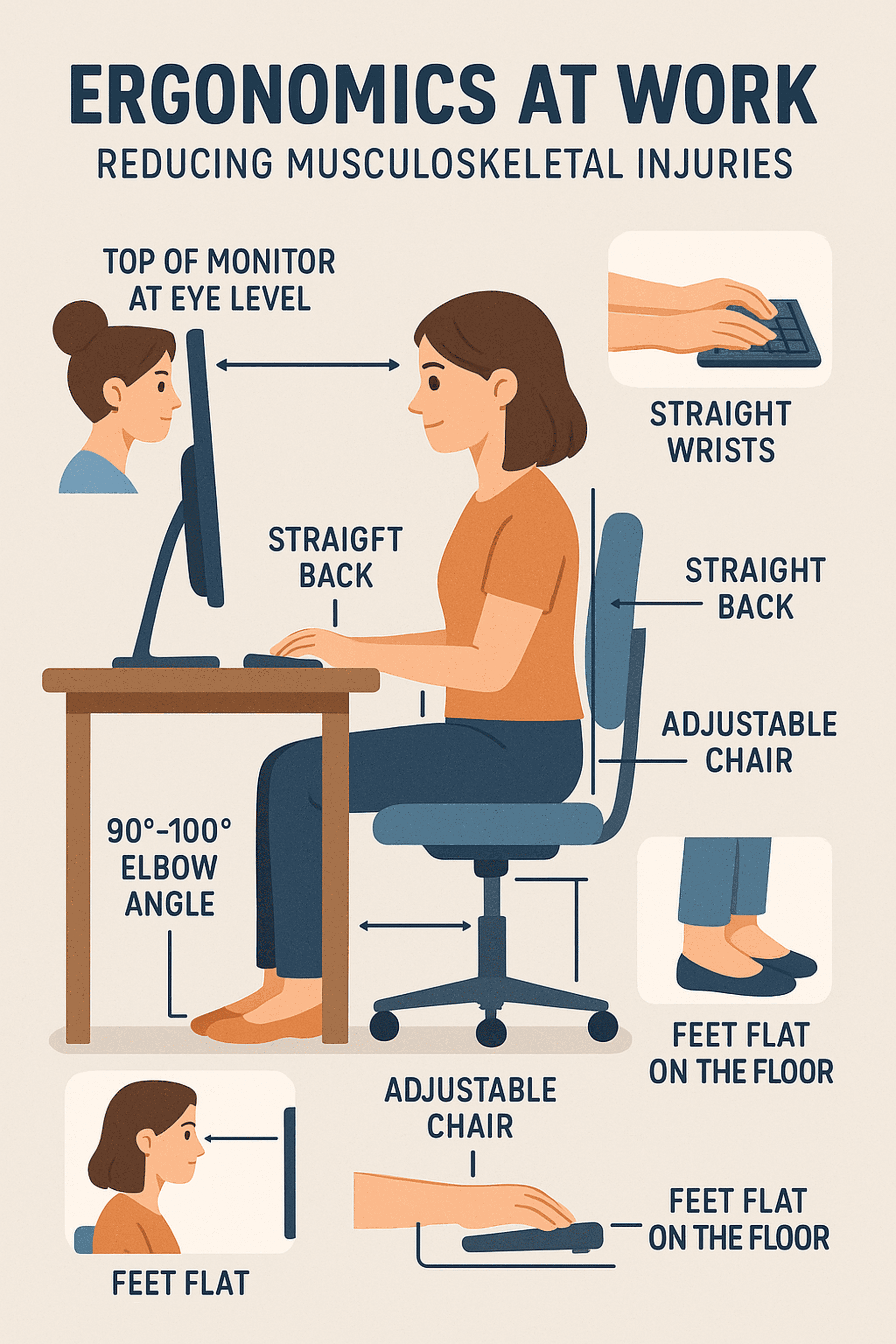
Welcome back to Rinath HSE Hub! Today, we're diving deep into a topic that underpins the health, safety, and productivity of any workforce: Ergonomics. Specifically, we'll unravel how a proactive approach to workplace ergonomics can dramatically reduce the prevalence and severity of debilitating musculoskeletal injuries (MSIs).
Musculoskeletal injuries are a global health concern and a leading cause of disability worldwide. In the workplace, they represent a significant challenge, accounting for a large percentage of lost workdays, workers' compensation claims, and reduced productivity. These injuries affect our muscles, tendons, ligaments, nerves, and blood vessels, manifesting as everything from persistent back pain and neck stiffness to more severe conditions like carpal tunnel syndrome, tendonitis, and disc herniations. The good news? Many, if not most, MSIs are entirely preventable through the strategic application of ergonomic principles.
Understanding the Essence of Ergonomics
So, what exactly is ergonomics? It's often misunderstood as simply buying an "ergonomic chair." However, ergonomics is a much broader, scientific discipline. It's the science of designing and arranging workplaces, products, and systems so that they fit the people who use them.
The core objective of ergonomics is to optimize the interaction between humans and their work environment. This isn't just about comfort; it's about enhancing efficiency, productivity, and critically, safety and well-being. It draws on various fields, including anatomy, physiology, psychology, and engineering, to create work systems that align with human capabilities and limitations. Instead of forcing the worker to adapt to a poorly designed tool or workstation, ergonomics adapts the tool or workstation to the worker. This human-centered design approach is fundamental to preventing strain, fatigue, and injury.
The Unseen Battle: How Poor Ergonomics Leads to MSIs
When work environments are not ergonomically sound, our bodies are subjected to various stressors that accumulate over time, often leading to MSIs. Let's break down the primary culprits:
Awkward Postures: These are positions that deviate significantly from the body's natural alignment. Examples include twisting the torso, bending excessively at the waist or neck, reaching overhead repeatedly, or working with wrists bent. Prolonged awkward postures can compress nerves, stretch tendons, and strain muscles, leading to chronic pain and inflammation.
Repetitive Motions: Performing the same movements repeatedly, especially under high force or in an awkward posture, can cause microscopic tears and inflammation in tendons and muscles. Common examples include extensive typing, assembly line work, or scanning items at a checkout. The cumulative effect of these small stresses can overwhelm the body's natural repair mechanisms.
Forceful Exertions: Applying significant physical force to complete a task puts immense strain on muscles, tendons, and joints. This could involve lifting heavy objects, pushing or pulling heavy carts, or gripping tools tightly. When combined with awkward postures or repetitive movements, the risk of injury skyrockets.
Vibration: Prolonged exposure to localized vibration (e.g., from power tools like jackhammers or grinders) or whole-body vibration (e.g., from heavy machinery or vehicles) can damage blood vessels, nerves, and joints, leading to conditions like Hand-Arm Vibration Syndrome (HAVS) or back pain.
Contact Stress: This occurs when a hard or sharp object presses against a part of the body, compressing soft tissues, nerves, or blood vessels. Examples include resting wrists on a sharp desk edge while typing or leaning on a workbench.
Static Postures: Maintaining a fixed body position for extended periods, such as standing still for hours or sitting without movement, restricts blood flow and can lead to muscle fatigue and discomfort. Our bodies are designed for movement, not prolonged stillness.
Environmental Factors: While not directly physical stressors, factors like extreme temperatures (hot or cold), poor lighting, or excessive noise can indirectly contribute to MSI risk. For instance, cold can reduce dexterity and increase the force needed for tasks, while poor lighting might cause workers to adopt awkward postures to see better.
Over time, these stressors cause micro-trauma, inflammation, nerve compression, and tissue degeneration, leading to conditions like carpal tunnel syndrome, cubital tunnel syndrome, various forms of tendonitis (e.g., tennis elbow, golfer's elbow), rotator cuff injuries, and chronic back and neck pain.
Core Principles of Ergonomic Design in the Workplace
Effective ergonomics isn't about rigid rules, but rather applying flexible principles to match the work to the worker. Here are some key principles:
-
Promote and Maintain Neutral Postures: The goal is to keep joints aligned in their natural, relaxed position. For example, when sitting at a computer, your back should be supported and upright, feet flat on the floor, wrists straight, and elbows close to your body. When standing, avoid excessive bending or twisting.
-
Reduce Excessive Force Requirements: Minimize the physical effort needed for tasks. This can involve using mechanical aids (hoists, dollies, power tools), redesigning workflows to reduce lifting or pulling, or simply reducing the weight or size of items handled.
-
Minimize Repetitive Motions and Static Loads: Vary tasks to reduce the frequency of highly repetitive movements. Implement job rotation schemes where possible, allowing different muscle groups to be used. Encourage frequent, short micro-breaks (30-60 seconds) every 20-30 minutes and longer breaks to move, stretch, and change posture.
-
Ensure Adequate Clearance and Reach: Design workstations and layouts to provide sufficient space for movement and to keep frequently used items within an easy, comfortable reach envelope, avoiding excessive stretching or awkward reaching.
-
Prioritize Adjustability and Customization: Recognizing that people come in all shapes and sizes, workstations, chairs, tools, and equipment should be easily adjustable to accommodate individual differences. This is crucial for achieving neutral postures for everyone.
-
Optimize Environmental Conditions: Ensure proper illumination to prevent eye strain and awkward viewing postures. Control temperature and humidity within comfortable ranges. Reduce noise levels to prevent distraction and stress. Mitigate vibration through damping, isolation, or the use of anti-vibration tools.
-
Provide Clear Visual Feedback and User-Friendly Controls: Design controls and displays to be intuitive, easy to understand, and operate, reducing cognitive load and errors.
Practical Strategies for Reducing MSIs Through Ergonomics
Implementing ergonomics requires a multi-faceted approach. Here's how you can proactively address MSI risks:
1. Conduct Comprehensive Ergonomic Assessments:
-
-
Identify High-Risk Tasks: Start by identifying jobs or tasks with a history of MSIs or known ergonomic risk factors (e.g., heavy lifting, sustained postures, highly repetitive work).
-
Systematic Observation: Observe workers performing their tasks. Look for awkward postures, forceful exertions, repetitive movements, and other risk factors.
-
Employee Interviews: Talk to employees! They are the experts on their jobs and often have valuable insights into discomfort or difficulties.
-
Utilize Assessment Tools: Employ standardized tools like the NIOSH Lifting Equation for manual handling, RULA (Rapid Upper Limb Assessment) for assessing upper limb disorders, or REBA (Rapid Entire Body Assessment) for whole-body posture analysis.
-
Documentation: Document findings, potential risks, and recommended solutions.
2. Invest in Ergonomic Equipment and Design:
-
Adjustable Seating: Provide chairs that offer lumbar support, adjustable seat height, backrest tilt, and armrests.
-
Standing Desks/Workstations: Offer sit-stand options for office workers to promote movement and reduce static loads. For industrial settings, ensure workstation heights are adjustable for both sitting and standing tasks.
-
Ergonomic Keyboards & Mice: Consider split keyboards, vertical mice, or trackballs to promote neutral wrist postures.
-
Monitor Arms: Allow monitors to be adjusted to eye level and optimal viewing distance.
-
Anti-Fatigue Mats: Use these for jobs requiring prolonged standing.
-
Material Handling Aids: Implement hoists, conveyors, lift tables, or hand trucks to eliminate or reduce manual lifting and carrying.
-
Ergonomic Hand Tools: Provide tools with comfortable grips, reduced vibration, and designs that minimize forceful gripping or awkward wrist positions.
3. Implement Robust Training and Education Programs:
-
Awareness: Educate all employees, from management to frontline staff, on what ergonomics is, why it's important, and the risks of MSIs.
-
Proper Body Mechanics: Train on safe lifting techniques, proper posture for sitting and standing, and how to adjust their workstations.
-
Self-Assessment: Empower employees to identify early signs of discomfort and understand how to make basic ergonomic adjustments themselves.
-
Importance of Breaks: Emphasize the critical role of micro-breaks, stretching, and changing postures.
4. Foster a Culture of Movement and Early Intervention:
-
Encourage Breaks: Actively promote and schedule regular stretching and movement breaks, especially for those in static or repetitive roles. Consider simple workplace stretching programs.
-
Early Reporting: Establish clear, non-punitive channels for employees to report discomfort, aches, or early symptoms of MSIs. Early intervention with medical assessment and ergonomic adjustments can often prevent minor issues from becoming chronic injuries.
-
Open Communication: Create an environment where employees feel comfortable providing feedback on their workstation setup or job tasks.
5. Ensure Management Commitment and Leadership:
-
Resource Allocation: Leaders must allocate sufficient resources (time, budget, personnel) for ergonomic assessments, equipment, and training.
-
Policy Development: Integrate ergonomic principles into safety policies, purchasing guidelines for equipment, and job design processes.
-
Lead by Example: Managers and supervisors should demonstrate good ergonomic practices and actively participate in ergonomic initiatives.
-
-
-
-
The Tangible Return on Investment (ROI) of Ergonomics
Implementing sound ergonomic practices isn't just a cost or a compliance checkbox; it's a strategic investment with significant returns. Businesses that prioritize ergonomics often see:
-
Reduced Injury Costs: Fewer MSIs directly translate to lower workers' compensation premiums, reduced medical expenses, and decreased costs associated with lost workdays and temporary disability.
-
Increased Productivity: Comfortable employees are less fatigued, more focused, and can perform tasks more efficiently and with fewer errors.
-
Improved Employee Morale and Retention: When employees feel their well-being is valued, job satisfaction increases. This leads to higher morale, reduced absenteeism, and better employee retention rates, minimizing recruitment and training costs.
-
Enhanced Product Quality: Less fatigue and discomfort mean fewer mistakes, leading to higher quality products or services.
-
Reduced Presenteeism: Employees who are in pain might be at work ("present") but are unproductive ("absent"). Good ergonomics reduces this "presenteeism," ensuring employees are fully engaged.
Conclusion
Ergonomics is far more than a buzzword; it's a vital component of a holistic health and safety management system. By proactively identifying and mitigating MSI risk factors, integrating ergonomic principles into every facet of workplace design, and fostering a culture of continuous improvement, organizations can protect their most valuable asset – their people. The result is a healthier, safer, and more productive workforce that benefits everyone.
Let's work together to build workplaces where well-being is paramount, and musculoskeletal injuries become a thing of the past.
Stay safe, and see you next time on Rinath HSE Hub!
 Athy Ricky
Athy Ricky